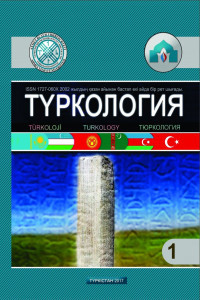EPİK GELENEĞİN VARISLIĞI: «KİTAB-İ DEDE KORKUT» VE «KOROĞLU» DESTANLARI
"Köroğlu" destanı kahramanlık eposu olarak kendisinden önceki eposun, "Dede Korkut"un dönüşmüş türevidir. Önceki epos Oğuz eposudur ve burada Oğuz dönemi, Oğuz ruhu açık-seçik gözüküyor. "Köroğlu" ise yeni dönemin, müteakip devrin eposudur. "Dede Korkut" eposu`nun Oğuz döneminin, "Köroğlu"nun da kendi döneminin kahramanlık ruhuyla kopmayan ilişkileri bulunmaktadır. "Köroğlu" destanının Azerbaycan folkloru ve diğer halkların folkloru bağlamında çok büyük olay olması, bu epos`un özel gelişim sürecinden geçtiğinin göstergesidir. Yani "Köroğlu" eposu zaman içinde özel olarak gelişmiş, büyümüş ve muhteşem hale gelmiştir. "Köroğlu" destanı aynı zamanda "Dede Korkut" eposunun epik yapımı bakımından varisidir.
Gerçek şu ki, destanlar yüzyıllar boyu cilalanarak ve büyüyerek günümüze varıyor. Fakat onun büyüme süreci tarihin muhteşem hafızası olmadan mümkün değildi.
Anahtar Kelimeler:
Epos, Folklor, Azerbaycan destanı, “Dede Korkut” eposu, “Koroğlu” destanı
EPIC TRADITION: EPIC "THE BOOK OF MY GRANDFATHER KORKUT" AND "KOROGLU"
The plots of “Koroghlu” are keeping the plots of the epos of “Dada Khorgud”. So, here the heroism of brave men is mentioned as it is noted in “Dada Khorgud”. Being in the forms of the marches, battles and trips these heroisms are the property of structure of Turkish eposes beyond “Kitabi-Dada Khorgud” and “Koroghlu”. The connection of Turkish eposes with the marches, battles and trips is coming from the style of Turkish living. “Koroghlu” is the heir of “Kitabi-Dada Khorgud” as the epos of heroism. As the epos “Koroghlu” was not created by itself from nothing or at once. Both of the eposes are the product of Azerbaijanian-Oghuz traditions of the art of narrator. That is, “Koroghlu” had to be established on the base of the epic rules of “Dada Khorgud”.
Keywords:
Destan, Folklor, Azerbaizhan destanları, Epos "Kitabi-Dede Korkut", Epos "Koroglu",
___
- 1. Cəfərov N. ,,Köroğlunun poetikası”, Bakü BDÜ, 1997, 46 seh.
- 2. Kitabi-Dede Korkut. F. Zeynalov və S. Alizade neşri Bakü Yazıcı 1988, seh 265.
- 3. Köroğlu. Tertibçi M.H Tahmasib, redaktörü H. Araslı, 2ci neşr, Bakü, Azerb. EA, 1956, səh 456.
- 4. Huluflu V. Köroğlu, Bakü 1929, seh 159.d
- ISSN: 1727-060X
- Başlangıç: 2002
- Yayıncı: Hoca Ahmet Yesevi Uluslararası Türk-Kazak Üniversitesi
Sayıdaki Diğer Makaleler
DEDE KORKUT ZAMANINDA SIRDERYA VADİSİNDE OZANLIK GELENEĞİNİN OLUŞUM AŞAMALARI
İŞTEK MESELESİ VE ORTA ASIRLARDA BAŞKURTLAR
YUSUF HAS HACİB’İN DÜNYA GÖRÜŞÜNDE «INSAN VE EVREN»İN KARŞILIKLI UYUMUNUN TANIMI
KONTRAST DİLBİLİMİNİN GELİŞİM TARİHİ
ESKİ TÜRK YAZITLARINDA KİŞİ/İNSAN ETNO KAVRAMININ İNSANLIK POZİSYONUNU GÖSTEREN DİLSEL BİRLİKLER
Raushan BAİYMBETOVA, Gulimzhan ZHYLKYBAY
AZERBAYCAN'DA TÜRKOLOJİ ÇALIŞMALARI'NIN KISACA TARİHÇESİ
A.Tikhonov’un «Rus Dili Sözlüğü» Çalışmasındaki Kompozit Özellikleri
İKİ AŞK BALENİN KOREOGRAFİK ÖZELLİKLERİ
MÜZİKSEL TÜRKOLOJİ VE ENSTRÜMAN ADLARININ INCELEME MESELESİ
Gulzhamal KORTABAYEVA, Malike SHAYKHYSTAMOVA
EPİK GELENEĞİN VARISLIĞI: «KİTAB-İ DEDE KORKUT» VE «KOROĞLU» DESTANLARI
